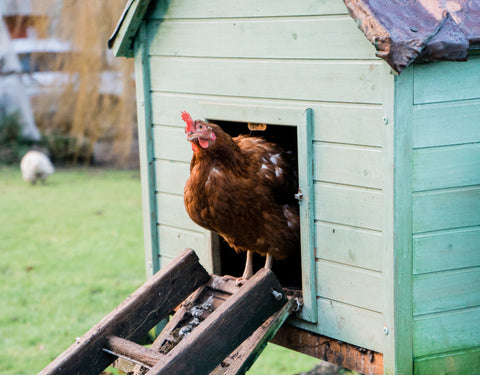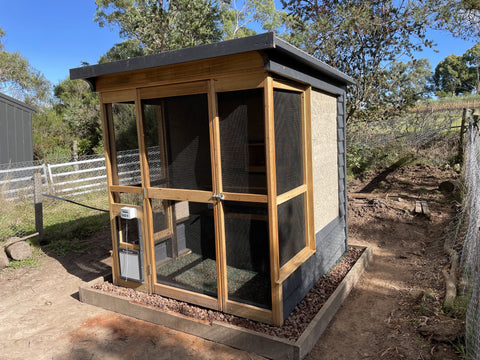Keeping your hens warm, dry and comfortable in their chicken coop will significantly reduce the number and size of any problems or issues that might come your way. This blog post is based on the 2nd presentation in our three-part Winter Series, where we looked at all the essential areas that we need to be aware of in order to create an ideal environment in which our flock can thrive. A video of the presentation can be found at this link or at the end of this post.
Coop flooring
Concrete is ideal as it is easy to clean and prevents pests or predators from digging underneath. Strong, galvanised or stainless steel aviary mesh is also suitable along with concrete pavers. Wooden boards can also work but must be supported above ground level to avoid any rot.
Bedding and nesting
Nest boxes and perches
Nests should always be lower than perches to discourage sleeping in nest boxes at night. They should be cosy and dark, so using a curtain over the entrance to the nest works well. Perches should be around 4 cm square with rounded edges and made from hardwood, metal or plastic. A ladder configuration works well with 30 cm space for each hen. If your coop has a droppings tray, clean it more frequently during winter as droppings won’t dry out nearly as fast as in the warmer months.
Coop integrity
Thoroughly inspect your chicken coop and run periodically, fixing all gaps and replacing any damaged boards. Plug small holes with steel wool to stop rodents, but ensure that there is adequate ventilation at or around the apex of the coop to release ammonia fumes.
Covered run
Keep the run as waterproof as possible using 20 cm eaves and 25 cm skirting boards around the bottom perimeter. Place a wall on the prevailing wind side of the run to stop excessive driving rain from entering and dampening the bedding materials.
Enrichment
Provide temporary and permanent enrichment for your flock. Temporary enrichment can be provided by using healthy,
Feeders and drinkers
Hang or stand feeders and drinkers at least 25cm high. Keep the feeder in a completely dry area and use a good quality
Feeding
Any scraps given to hens should ideally be vegetable-based and given sparingly. They should always go onto a
Parasite detection
Check hens each month and feel for any lightweight hens along with checking around the vent area for any nit eggs which shows that parasites have been active. If you discover any mites or lice, treat over 7 days with
Parasites and disease prevention
Adding
Housekeeping
Replace bedding at least twice each year and remove any wet or caked bedding or nesting when you see it. It’s a great idea to use a sanitiser on all surfaces when chickens are out of the coop. Sprinkle
Different options for bedding, litter, and nesting
Ideal bedding/litter is…
- Absorbent
- Non-caking
- Non-toxic
- Resistant to mould and bacterial growth
|
Material |
Benefits |
Drawbacks |
|---|---|---|
|
Hemp ★ ★ ★ ★ ★ |
|
|
|
Wood Shavings ★ ★ ★ ★ ☆ |
|
|
|
Sand/Gravel ★ ★ ★ ☆ ☆ |
|
|
|
Sawdust ★ ★ ★ ☆ ☆ |
|
|
|
Straw/Hay ★ ★ ☆ ☆ ☆ |
|
|
|
Bark ★ ★ ☆ ☆ ☆ |
|
|
Setting up your chicken coop and run correctly will enable you to provide a healthy and productive environment for your backyard flock. Not only will it minimise the problems that can be encountered, but it will save money and effort over time. Your flock and back pocket will thank you for the little time and effort put in at the very beginning – an effort that will ensure your success over the long term.







Comments (2)
Thanks for all the helpful tips!
thank you for making this article very useful and keep up the good work